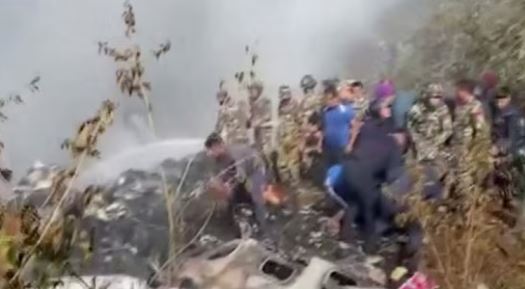Kathmandu: The pilots of the Yeti Airlines aircraft that crashed in Nepal’s resort city of Pokhara may have failed to fully deploy the wing flaps while attempting to land, leading to a stall, a media report said Thursday.
January 15, a Yeti Airlines aircraft crashed into a gorge near the newly-built airport in Pokhara, killing 72 all on board, including five Indians, in the country’s worst air disaster in 30 years.
An aircraft coming to land has the flaps at the back of the wings fully down to provide more control at low speed and prevent stalling, the Kathmandu Post reported.
The exact reason behind the crash will be known only after an examination of the flight data recorder, or the black box, the report added.
A nine-member team from France is also enquiring with the airlines’ staff and concerned authorities in Pokhara to understand details of the ATR-72 aircraft crash, according to an official from Yeti Airlines.
The aircraft that took off from Kathmandu at 10:30 am crashed into the Seti river gorge, killing all four crew members and 68 passengers. One person on board the aircraft is still missing.
The government has formed a five-member probe committee to investigate the crash.
Two mobile videos went viral immediately after the crash.
One showed the aircraft banking sharply left and then falling after a stall while the second video appeared online several hours after the incident and showed an Indian passenger identified as Sonu Jaiswal live streaming from the plane seconds before it went down.
The footage showed that the flaps were not fully down, leading experts to suspect that the aircraft might have stalled for this reason, the report added.
Another senior ATR captain Kumar Pandey was quoted as saying by the Kathmandu Post, “I was stunned after watching the video.”
“From the window, we can clearly see that one side of the wing flap of the aircraft was not fully deployed. I speak on the basis of the video footage, which is subject to a detailed investigation.”
In 2007-08, Pandey flew the same aircraft that once belonged to the now-defunct Kingfisher Airlines of India, the report said.
“It looks like the pilots messed up. If that’s the case, it’s a big negligence. They didn’t follow the basic checklist,” Pandey said.
Referring to the landing checklist, the co-pilot normally reports when the aircraft has descended to 1,000 feet, the level at which the aircraft is supposed to be fully stabilised for landing, according to the report.
Normally, at the speed of 160 knots or 296 kilometres per hour, the pilot releases the landing gear. At this stage, the flaps should be deployed at 15 degrees.
When the speed goes below 150 knots or 277 kilometres per hour, the flaps should be set at 30 degrees.
This process stabilises the aircraft for a smooth landing. The pilots then align the aircraft with the runway. At this phase, the flaps should be set at 30 degrees to reduce the speed.
“But the video shows the flaps at 15 degrees,” Pandey said. According to him, extending the flaps, particularly beyond 30 degrees, results in significant levels of drag. When a steep approach angle and a short final come together, the landing becomes critical, which could be the case with Yeti Airlines Flight 961.
“The pilots may have omitted the mandatory final landing checklist,” the report quoted at least four ATR captains and at least three experts who have extensive knowledge of the matter.
Meanwhile, aviation experts in India said on Sunday that mishandling, malfunctioning of an aircraft system or pilot fatigue could be among the factors that caused the plane crash in Nepal.
A pilot with a regional carrier, who has been flying ATR planes for nearly two decades, said on the condition of anonymity that the particular aircraft could have suffered a stall or there could have been a pilot error.
The factors that led to the crash will be clear only after the completion of the investigation, the pilot added.
–PTI
